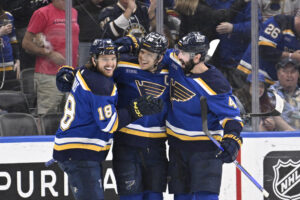The 2021 NHL Draft class is full of fun names, but there’s arguably none better than Red Savage. If draft rankings were based on names, he’d arguably be number one on many lists. But he brings much more to the table than just a great name. There’s a reason he’s been ranked within the first two rounds of this draft class.
Red Savage Prospect Deep Dive
What The Experts Are Saying
C.R. Davies of The Hockey Writers: “Savage brings a fantastic two-way game, he’s a Swiss Army knife, to say the least. His ability to get back on the defensive end and shut down the offensive rush is remarkable, and a skill that he can utilize for years to come. He possesses a high hockey IQ that also allows him to carry the puck into the offensive zone and create some scoring opportunities for his linemates.”
Gabriel Foley via St. Louis Game Time: “Right off the bat, Savage’s clear specialty is his two-way ability. He’s easily one of the best two-way forwards in this draft and could very easily assume a center-role in the NHL. That’s a big jump and not something every C prospect can say. To be able to so confidently say it for Savage should speak to his ability in the defensive zone and the faceoff dot.”
Red Savage, via an exclusive interview, on himself: “What I’m most confident in is my tenacity and moving my legs. It’s something that drives my game throughout the year and throughout my life. My work ethic and moving my legs as much as possible to try to break up plays defensively and go on the attack offensively.”
Red Savage Draft Profile
Born May 15th, 2003, in Scottsdale, Arizona, Savage is a versatile forward, who can play just about any forward position. Primarily playing center, the 5’11” and 181-pound forward most recently played for the US National U18 team and the USNTDP in the USHL. For the U18 team, he produced 18 goals and 24 assists for 42 points in 46 games. Meanwhile, for the USNTDP, Savage recorded 10 goals and 10 assists for 20 points in 22 games.
Also playing in the U18 World Junior Championship with the United States, Savage wore the “C” as captain and recorded just one goal in 5 games. Overall, his performance and subsequent production have earned him a ranking as high as 43rd by McKeen’s Hockey and as low as 89th by Dobber Prospects. On my personal board, Savage ranks 23rd. While that may seem very high, his low rankings from other experts could be due to his not-so-great World Juniors performance more than anything else. Savage is committed to Miami University in Ohio for the 2021-22 season.
Skating Abilities
On the surface, Red Savage is a very good skater. He’s fast, has strong edges, and displays really good balance when fending off opposing players. While he does lack an extra gear to really break away from defenders with consistency, he’s still faster than most on the ice. His agility is also high-end, as he can stop on a dime, execute tight turns without losing much speed, and follow the play extremely well.
Taking a deeper dive into his stride, he’s almost technically sound. Savage displays lower-body strength and explosion as he’s pushing off his back foot. His strides are long and wide, generating a lot of power. On top of that, he displays really good ankle flexion, keeping his knees over his toes consistently. When performing crossovers to accelerate up ice, he keeps his feet tight, getting in as many quick steps as he can to generate speed quickly. The only issue from a technical standpoint is his knee bend. He doesn’t get low enough to fully take advantage of his powerful stride extensions, and because he does have a good ankle bend, he leans too far forward in the process. A lot of his weight is balanced on his toes, which again, limits his power and balance.
Red Savage’s Transitional Abilities
Savage is very conservative in transition. He prefers to dump the puck in deep and forecheck, using his skating and strength to gain offensive zone possession. While that’s perfectly fine, the stats I track on Savage don’t look pretty because of it. In fact, he is currently ranked dead last among tracked forwards from his play in the World Juniors when it came to entering the offensive zone with possession. Savage had a 25 percent controlled zone entry percentage in three tournament games I tracked. To put this into perspective, he dumped the puck in on 43.75 percent of his entry attempts.
Conversely, when it came to exiting the zone, Savage fared much better. His strong two-way game was a constant trait of his effectiveness when clearing the defensive zone. In fact, Savage ranks first among those same forwards in the three tournament games that were tracked in zone exits with possession. Savage had a controlled zone exit percentage of 57.
If Savage can work on taking a few more risks in the neutral zone and find a better balance between taking risks and playing it safe, he could be a very solid transitional player at the NHL level.
Offensive Game
Red Savage is a very interesting player when it comes to the offensive side of things. Gabriel Foley, another scout who I have talked to a lot, loves Savage and brings him up a fairly decent amount. That said, he mostly talks about Savage’s passing ability. It’s quite clear when watching him that he plays with an immense amount of awareness in the offensive end. But his passing tends to be very flashy and not a consistent trait.
It showed in the World Juniors, as through three games, he attempted just 14 passes in the offensive end. He completed 10 of them (71.43% passing accuracy). Of those 14, just four were “simple” passes and six were cycle passes. Simply put, he’s a creative passer, who deviates how he moves the puck based on the defensive coverage.
As for his shooting, he fired five shots towards the net, hitting the target twice (40% shooting accuracy) and scoring once. Out of those five shots, three came from the slot area. All of his shots on target, including his only goal, occurred in the high danger shooting area within the slot.
Red Savage’s Offensive Style
As stated earlier, Savage’s game is predicated on his ability to read the opposing team’s defensive coverage. He constantly keeps his feet moving, seemingly always putting himself in good positions to receive a pass and be a threat. When he isn’t finding pockets of space near a teammate with the puck as an easy outlet, he’s parking himself in the slot. Based on the movement of his teammates and the opposing defenders, he’ll pop out of the net-front area and get open in the mid-slot as a high-danger threat. He’s also really good at forcing turnovers with his aggressive forechecking and high-energy play. Despite his struggles in the World Juniors, he was constantly frustrating defenders with his ability to force turnovers.
His offensive positioning is excellent, and he knows how to exploit defensive zone coverages when he doesn’t have the puck. The issue is, when he does have the puck, he tends to force passes into high-danger areas. Again, when he gets the puck to teammates in those spots, it’s going to be on highlight reels for the year. The problem is, and again it showed in the World Juniors when he went 0-for-4 on centering passes, he doesn’t hit those passes consistently.
While his IQ is sky-high and the flashy plays showcase his potential, it’s not easy to project just how good he’ll be in the future. Working on his shot and shooting the puck more would add another layer to his offensive game. That could open his game up for more of those high-danger passes. Again, his offensive game is hard to project, but he has really good potential there.
Defensive Zone Ability
Arguably the most valuable aspect of Savage’s game, as well as the most translatable, is his defensive zone play. Looking at the quotes from the start of this article, it’s clear that it’s a shared thought. His overall awareness translates to the defensive zone. He can read the play well and anticipate where the opposition will go before they get there. He does not puck chase or puck watch either, staying very disciplined in his positioning.
Talking about positioning, he does an excellent job clogging up the middle with his body and stick positioning. Constantly, you’ll find Savage dropping his stick flat on the ice to cover cross-ice passes or centering feeds. He supports his teammates down low and currently possesses the strength to defend the cycle well. Going to the NCAA for next season will allow him to further build up that strength. That will allow him to hold up at the NHL level against men. Similar to his forechecking abilities, Savage is aggressive on puck-carriers when the right situation calls for it. He utilizes his stick so well, causing a ton of turnovers.
Red Savage’s NHL Comparison and Potential
Red Savage has really good potential. He has the size currently while going the NCAA route with a better schedule to continue bulking up, to pair with his skating already. His defensive game is translatable to the NHL, and his IQ is high-end. If he can become more disciplined in the offensive zone with his passes, and become more consistent, Savage projects as a top-six center. As it currently stands, however, he looks every bit the part of a third-line checking forward with a strong shut-down ability.
Based on style only, not based on how he could turn out at the NHL level, Savage reminds me of Colorado Avalanche forward, Gabriel Landeskog. Landeskog is a physical, two-way forward with leadership abilities. Savage recently captained the US U18 team, and Landeskog captains the Avalanche. Landeskog is not the offensive dynamo that his linemates, Mikko Rantanen or Nathan MacKinnon, are. However, he grades out well in the defensive zone. Landeskog rates in the 91st percentile of players in defensive impact, per Evolving-Hockey’s player cards. His offensive value derives from his ability to play a high-energy, physical game, getting to the dirty areas and doing the work to free his linemates up. Landeskog’s playmaking ability is high-end, and he possesses a very good shot.
Savage needs to build on his shooting ability and clean up his passing skills to truly be a Landeskog-esque player. However, he definitely has that aggressive play style that will free up teammates, as well as the leadership intangibles.
Red Savage Interview
Linked below is an interview with Red Savage, where we dive into the film and break down what makes Savage such a talented prospect. Thanks for reading, and thanks for watching the interview!






